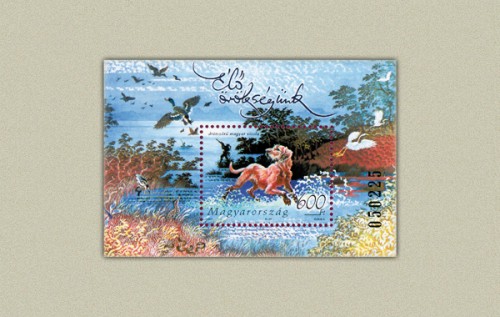
1. MAGYAR - ÉLŐ ÖRÖKSÉGÜNK III - KUTYÁK - BLOKK - Bélyeg rendelési kód: 2007 év bélyegei kompletten
2. ENGLISH - OUR LIVING HERITAGE III – DOGS - BLOCK - Order code of the stamp: 2007 Year stamps complete
3. GERMAN - Unser lebendiges Erbe III - HUNDE - Block - Marke die sprechstunde kode: 2007 Jahr Briefmarken komplett
1. MAGYAR - ÉLŐ ÖRÖKSÉGÜNK III - KUTYÁK - BLOKK
A Magyar Posta alkalmi bélyegblokk és négy címletből álló bélyegsorozat kibocsátásával mutat be néhány jellegzetes hazai kutyafajt.
A drótszőrű magyar vizsla alig fél évszázada jelent meg a magyar nemzeti vadászkutya-fajták palettáján. Létrehozásának gondolata abból indult ki, hogy a kiváló képességű, rövid szőrű magyar vizsla a téli nagy hidegben, havas, vizes, nehéz terepeken - a drótszőrű német vizslához hasonlóan - megérdemelne egy „védőruhát”. Élénk, barátságos, kiegyensúlyozott, könnyen tanítható. Alapvető tulajdonságai közé tartozik a kiváló kapcsolattartó képessége.
A blokk keretrajzán és bélyegképén egy drótszőrű magyar vizsla látható, a rá jellemző környezetet idéző grafikai kom-pozíció részeként. A bélyegsorozat címletein jellegzetes hazai kutyafajták láthatók. A színes hátterű grafikák részeként – a blokkhoz hasonlóan – az állat élőhelyére, illetve környezetére utaló motívumok jelennek meg. A bélyegképe-ken névérték szerinti sorrendben komondor, erdélyi kopó, kuvasz és pumi látható. Az alkalmi borítékon a nyájterelés elevenedik meg. Az alkalmi bélyegzőt egy kuvasz stilizált rajza díszíti.
Megjelenési időpont: 2007. május 9.
Forrás: Philatelia Hungarica Kft., Magyar Posta
2. ENGLISH - OUR LIVING HERITAGE III – DOGS - BLOCK
Magyar Posta presents breeds of dogs typical of Hungary by issuing a special stamp block and a set of four stamps.
The wire-haired Hungarian vizsla appeared among the national hunting dogs of Hungary barely half a century ago. The thought that prompted the creation of the breed was that the short-haired Hungarian vizsla with its excellent quali-ties deserved a “protective coat” for snow and water in bitter winter weather, just like the German wirehaired pointer. It is a lively, friendly, well-balanced dog which is easy to train and makes strong bonds with people.
The komondor is an ancient Hungarian sheepdog of Asian origin. Its sturdy body is entirely covered by thick long shaggy fur that is inclined to become matted. By day it likes to lie for long periods watching over its territory. By night it moves persistently. It has a lively temperament. It does not have a friendly nature and is naturally suspicious. It is absolutely loyal to its owner, but is also highly independent with a strong character. It attacks boldly without a sound.
The Transylvanian hound developed in historic Hungary. The Hungarians in Transylvania bred and used these hounds for hunting. The style of drive hunting required persistence and courage, and a keen sense of smell, excellent memory and sense of direction make these hounds ideal for spooring. They are goodnatured, brave, calm and well-balanced, yet determined and lively.
According to some sources, the kuvasz came to Hungary when the Magyar tribes settled in the Carpathian Basin. Due to its large build, it was used to watch over and protect livestock. Its white, wavy fur and pleasing appearance radiate nobility and strength. It can run long distances without tiring. Its extraordinary intelligence is a consequence of selection by the shepherds. It learns with ease and does not forget.
The pumi developed from the spontaneous crossing of the Hungarian breed puli and a terrier-like sheepdog of French origin, as besides large sheepdogs minding the flock smaller sheepdogs were also needed. A clever and loud breed with a pushy nature and a keen sense of smell, its fur is shorter than the puli’s and does not get matted. It never tires and can be taught to do almost anything that its strength and build allows.
In the frame and the stamp design of the block a wire-haired Hungarian vizsla is depicted as part of a graphic composition recalling its usual environment. In the denominations of the set of stamps typical Hungarian breeds are shown. As in the block, the graphic designs have a coloured background and motifs referring to the surroundings associated with the dogs. On the stamp designs, in order of face value, the following breeds are shown: the komondor, Transylvanian hound, kuvasz and pumi. The special cover features a scene showing a flock being herded. The special postmark is a stylised drawing of a kuvasz. Source: www.magyarallat.hu
Date of issue: 9 May 2007
3. GERMAN - Unser lebendiges Erbe III - HUNDE - Block
Die Ungarische Post-hoc-Miniatur-und vier Stempel Stückelung der Frage stellt einige typische Haushunde.
Die Rauhhaar ungarische Vorstehhund fast einem halben Jahrhundert erschien in der ungarischen Jagd-Palette von Sorten. Die Idee der Schaffung davon ausgegangen, dass hochkarätige, kurzhaarige ungarische Vorstehhund auch im Winter Kälte, Schnee, Nässe, schwierigem Gelände - wie die Wire Haired Vizsla Deutsch - verdient eine "Schutzkleidung". Lebhaft, freundlich, ausgeglichen, leicht gelehrt. Grundlegende Eigenschaften umfassen die Fähigkeit, kontaktieren hoch.
Der Block und der Rahmen einer Thumbnail-Drahthaar ungarische Vorstehhund gesehen, die so charakteristisch für ihn, in denen der grafischen Umgebung als Teil der Com-Position. Die Briefmarken werden angezeigt typischer Hunderassen. Die Farbe Grafiken als Teil des Hintergrunds - die gleichen Block - Lebensraum der Tiere und die Umwelt eindrucksvollen Motive werden angezeigt. Der Nennwert der Größenordnung von Ken Vorschaubild Komondor, Siebenbürger Hund, Hündchen, Pumi und wird angezeigt. Die gelegentliche Umschlag nyájterelés lebendig. Die gelegentliche Stempel eines pooch ist mit einer stilisierten Zeichnung verziert.










